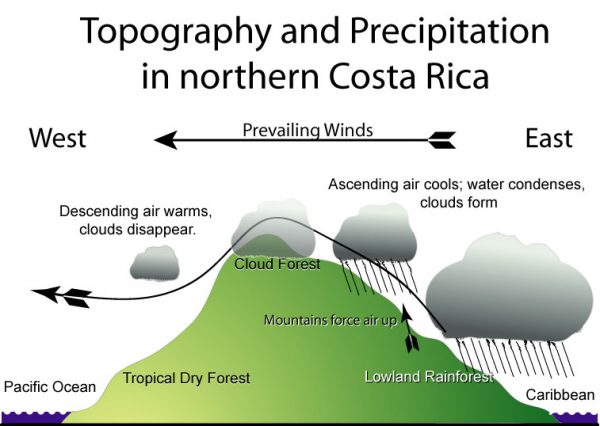Thursday, December 13th, 2018.
In this Daily -- the Rain Shadow effect in Las Catalinas
A slightly cooler morning today, with temperatures starting in the low 70s around dawn after a breezy evening last night. Expect that to change slowly as we reach midday, with both wind and temperatures picking up leading into the afternoon, with heat in the mid 80s and a breeze a little under 10mph. The dew point is at around 68F today, which is right around the average for town this time of year. For those unfamiliar with dew point, it is actually a better measure of how humid the air "feels", as it defines the temperature at which the humidity is 100% and dew starts to form. For example, during the gold season in Guanacaste, the dew point is down in the low 60s and the air feels quite dry, whereas during the green season the dew point can reach around 75, which feels very humid throughout the day.

One of the main contributors to the climate in Guanacaste is something called the Rain Shadow effect, displayed above. Costa Rica is only about 10 degrees north of the equator, so the effects of changing seasons are minimal in terms of temperatures and amount of sunlight, but the arrival of winter far to the north has a significant effect on conditions in the country. As the air cools up north, the trade winds (the same winds that bring with them our many migratory avian residents) cool and deposit much of their moisture in the form of snow as they cross North America. These winds then cross the Gulf of Mexico and hit the northeast section of Costa Rica, where they deposit much of their moisture on the lowland rainforests.
This is where the Rain Shadow comes into play. As these strong winds hit the mountains in the middle of Costa Rica, they push up and over, but much of the rain and moisture is deposited as the air reaches high altitudes, creating cloud forests like in Monteverde. The winds then continue over the peaks of the mountains and down into Guanacaste, where they bring drier air, warmer temperatures, and the gold season.
Interestingly enough, down the west coast in areas like on the Osa Peninsula, the massive mountains at the center of the continent actually prevent the trade winds from reaching the coast, leading to an entirely different ecosystem. It's an interesting phenomena, and part of the reason that Costa Rica has such a wide range of microclimates and biodiversity despite being a relatively small country.